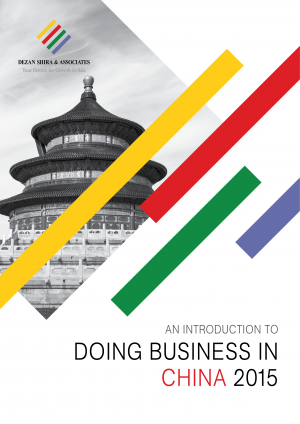Funding WFOEs in China: Critical Points on Pre-Incorporation Expenses and Thresholds
 By Maria Kotova, Senior Associate
By Maria Kotova, Senior Associate
International Business Advisory
Incorporation of a WFOE can be very time consuming in China. While overseas parent companies are rushing to start preparation work, additional pre-incorporation expenses can be incurred. This is typically because foreign investors tend to underestimate the pre-incorporation expenses required for setting up a WFOE. In other cases, a parent company that is unfamiliar with China’s pre-incorporation process may get into trouble with charging their paid expenses back after the WFOE legally exists.
In this article, we discuss some key points to consider when setting up a company in China and provide suggestions for tax and financial planning during the pre-incorporation process.
How to keep pre-incorporation expenses under budget?
Generally, investors are required to disclose the amount of subscribed capital to China’s Administration for Industry and Commerce (AIC) and Ministry of Commerce (MOFCOM), which will appear on the company’s business license after being formally incorporated. Although the minimum registered capital requirement was abolished in 2014, in practice, registration authorities still check whether the company’s subscribed capital is reasonable and can cover the WFOE’s operational costs for the first business year.
However, it may take a couple of months for a WFOE to obtain its business license (i.e., for it to legally exist), which allows it to open bank accounts for capital injection and pre-incorporation expenses. The most common expenses include office rent (a WFOE has to provide a lease contract with at least one year’s term to start the incorporation process), decoration, purchase of furniture, equipment, as well as service fees paid to various consulting and marketing firms. These expenses, paid by the parent company on behalf of the WFOE, can be difficult to transfer back due to China’s strict foreign exchange controls. It is important to note that, in this instance, there is still subscribed capital to be paid in.
 RELATED: Pre-Investment and Entry Strategy Advisory
RELATED: Pre-Investment and Entry Strategy Advisory
What is a temporary capital account and why might you need it?
A WFOE is permitted to open a temporary capital bank account under the parent company’s name during the pre-incorporation period and merge it with its official capital account after formal establishment. The temporary bank account needs to be approved by the State Administration of Foreign Exchange (SAFE) once a WFOE obtains the company name approval. This generally takes around one month, depending on the banks. The investor may wire foreign currency into this account and spend these funds on pre-operation and other expenses. The purchase of office equipment is subject to a review conducted by the bank, who will decide the legitimacy of payment and ownership on a case-by-case basis. However, the temporary bank account cannot be used to pay salary to employees, or to purchase any materials for future manufacturing activities.
The ceiling amount of the temporary capital account is usually US$300,000. Investors need to obtain special approval from SAFE for higher amounts. In practice, this amount should not exceed 20 to 30 percent of the total registered capital and will be examined by the SAFE depending on the WFOE’s type, size, and business activities. The temporary bank account is valid for six months and may be extended upon SAFE’s approval.
Importantly, the company’s petty cash cannot be used for foreign exchange settlement since there is no RMB account in place at this stage. As a result, foreign exchange settlement is a must for each transaction, which can be time consuming, particularly when the investor is abroad. Investors are advised to open a temporary bank account in the same bank as their overseas parent company. This is because most banks require the investor’s signature (original or a scanned copy) for a business account, and a shared bank may simplify the process.
What are the available options if the parent company didn’t open the temporary capital account, and wants to withdraw expenses already spent from the budget for the WFOE?
Companies that have paid all their expenses (including subscribed capital) directly via their overseas company account will face problems when trying to charge the paid expenses back.
Whether or not the expenses can be withdrawn is determined jointly by the bank and the SAFE. A bank might be reluctant to approve the withdrawal, as certain risks go hand in hand with such transactions.
There are several issues that need to be taken into consideration when determining whether expenses qualify for withdrawn. These include the time of payment, contractual parties, supporting documents (e.g., invoices), nature of the transactions, and location of the WFOE’s vendors (i.e., the WFOE’s partners, entrusted accounting firm, marketing firm and product suppliers).
In particular, the time when the payment occurs might be one of the key factors in the bank’s review. A WFOE is considered a legal entity once it obtains its business license. The expenses incurred prior to that are therefore likely to be deemed as the parent company’s expense.
In a case where the expenses occur after a WFOE has obtained its business license, the consistence of contractual flow, invoice flow and payment flow is important. This means that all the agreements signed during this period should be either between a WFOE and its supplier, or a three-party agreement which also involves the parent company. The invoice flow can be challenging – investors need to ensure they are issued in the name of the WFOE rather than its parent company. The final decision largely depends on the bank’s judgment, with additional supporting documents occasionally required according to the internal policies of the bank.
Even if both the bank and SAFE have approved the charge back, there is an additional consideration – China’s tax bureau. Most of these transactions (e.g., construction, marketing or consulting expenses) are subject to a withholding tax, which covers taxes such as value-added tax (VAT), corporate income tax (CIT) and local surtax, ranging from 14 percent to 20 percent depending on the description of the services in the agreement. Certain transactions, such as business travel expenses and accommodation, are tax free.
Please note that these requirements, the tax payable, and the time required can vary widely across different areas of the country depending on the specific situation of the company, local banks and tax bureaus.
![]() RELATED: Tax Planning for your Pre-incorporation Expenses in China
RELATED: Tax Planning for your Pre-incorporation Expenses in China
What are the other thresholds to consider after the WFOE is successfully established?
Obtaining general value-added taxpayer status can potentially help the WFOE save a large amount of taxes, as the status allows WFOEs to offset output VAT against input VAT. This status needs to be applied for and WFOEs must meet certain requirements.
A WFOE could also have paid for some expenses before they acquire general taxpayer status and may want to use the invoices they received to credit against output tax. This can be challenging in cases where the company’s vendors issue special VAT invoices prior to the effective date of the general VAT taxpayer status. Overlooking the invoice issuance date could result in a huge additional tax burden (the VAT rate for services is six percent and 17 percent for goods).
Recently, the SAT released Announcement 59 to clarify how to deal with input VAT incurred during the waiting period before the WFOE obtains general VAT taxpayer certification. More details regarding the status application procedure and tax deduction method can be found in our previous article, here. In practice, the new regulation is gradually implemented in China and challenges may still exist for taxpayers to get their input VAT recognized by the local tax officer. Therefore, companies are recommended to defer transactions with their vendors and delay the issuance of the special VAT invoices in order to reduce the input tax occurred during the waiting-for-status period.
Specialist law firms and accounting firms working separately often overlook some of these key challenges, as they tend to focus on only one side of the issue – mostly, the legal aspects of incorporation. Investors are therefore strongly recommended to have these specialists work side by side to ensure compliance while preparing for potential challenges and risks during the pre-incorporation process.
|
Asia Briefing Ltd. is a subsidiary of Dezan Shira & Associates. Dezan Shira is a specialist foreign direct investment practice, providing corporate establishment, business advisory, tax advisory and compliance, accounting, payroll, due diligence and financial review services to multinationals investing in China, Hong Kong, India, Vietnam, Singapore and the rest of ASEAN. For further information, please email china@dezshira.com or visit www.dezshira.com. Stay up to date with the latest business and investment trends in Asia by subscribing to our complimentary update service featuring news, commentary and regulatory insight. |

 An Introduction to Doing Business in China 2015
An Introduction to Doing Business in China 2015
Doing Business in China 2015 is designed to introduce the fundamentals of investing in China. Compiled by the professionals at Dezan Shira & Associates, this comprehensive guide is ideal not only for businesses looking to enter the Chinese market, but also for companies that already have a presence here and want to keep up-to-date with the most recent and relevant policy changes.
 Employing Foreign Nationals in China
Employing Foreign Nationals in China
In this issue of China Briefing, we have set out to produce a guide to employing foreign nationals in China, from the initial step of applying for work visas, to more advanced subjects such as determining IIT liability and optimizing employee income packages for tax efficiency. Lastly, recognizing that few foreigners immigrate to China on a permanent basis, we provide an overview of methods for remitting RMB abroad.
 Strategies for Repatriating Profits from China
Strategies for Repatriating Profits from China
In this issue of China Briefing, we guide you through the different channels for repatriating profits, including via intercompany expenses (i.e., charging service fees and royalties to the Chinese subsidiary) and loans. We also cover the requirements and procedures for repatriating dividends, as well as how to take advantage of lowered tax rates under double tax avoidance treaties.
- Previous Article Strategische Erwägungen bei der WFOE-Gründung in China, Teil 2: Holdinggesellschaft und Firmenname
- Next Article Trash or Treasure? Prospects for China’s Recycling Industry









